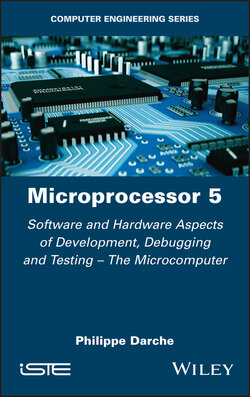Microprocessor 5

Реклама. ООО «ЛитРес», ИНН: 7719571260.
Оглавление
Philippe Darche. Microprocessor 5
Table of Contents
List of Illustrations
List of Tables
Guide
Pages
Microprocessor 5. Software and Hardware Aspects of Development, Debugging and Testing – The Microcomputer
Quotation
Preface
About the book
Multi-level organization
Introduction
PART 1
1. Development Chain
1.1. Layers of languages, stages of development and tools
1.1.1. Levels of languages
1.1.2. Development stages
1.1.3. Mixed-language programming
1.1.4. Compatibility and software interfaces
1.2. Fundamental software tools for development
1.2.1. Assembler
1.2.2. Linker
1.2.3. Loader/launcher
1.2.4. Disassembler
1.3. Assembly language
1.3.1. Software development methodology
1.3.2. Standardization of assembly language
1.3.3. Structure of a program
1.3.4. Macro-instructions
1.3.5. Addressing
1.4. Conclusion
2. Debugging and Testing
2.1. Hardware support
2.1.1. Generic electronic boards
2.1.2. Programmers
2.2. Debugging
2.2.1. Evolution
2.2.2. Functionality
2.2.3. Hardware emulators
2.2.4. Software debugging
2.2.4.1. Debugging monitor
2.2.4.2. Software and in situ simulators
2.2.4.3. Software debugging
2.2.5. Hardware support and debugging interfaces
2.2.6. Remote debugging and virtualization
2.2.7. Summary
2.3. Testing
2.4. Conclusion
PART 2
3. Changes in the Organization of the Earliest Microcomputers
3.1. Apple II
3.2. IBM PCs
3.2.1. The original PC
3.2.2. The XT
3.2.3. The AT
3.3. Chipset
3.3.1. Definition
3.4. Motherboard architectures
3.4.1. Form factors
3.4.2. Current motherboard architecture
3.5. Evolution of microcomputer firmware
3.5.1. Definition
3.5.2. Apple II
3.5.2.1. The system monitor
3.5.2.2. BASIC ROM
3.5.3. PC BIOS
3.5.4. Open firmware
3.6. Conclusion
Conclusion of Volume 5
Exercises
Chapter 1. Exercises
Acronyms
General. A
B
C
D
E
F
G
H
I
J
L
M
N
O
P
Q
R
S
T
U
V
W
X
Z
Miscellaneous
Units of measurement and unit prefixes
Electrical characteristics
Company or organization
Trademarks (™)
Registered trademarks (®)
References
Preface
Part 1 (Chapters 1 and 2)
Part 2 (Chapter 3)
Index
A
B
C
D
E
F
G
H
I
J
L
M
N
O
P
Q
R
S
T
U
V
W
WILEY END USER LICENSE AGREEMENT
Отрывок из книги
Series Editor
.....
This book gradually transitions from conceptual to physical implementation. Pedagogy was my main concern, without neglecting formal aspects. Reading can take place on several levels. Each reader will be presented with introductory information before being asked to understand more difficult topics. Knowledge, with a few exceptions, has been presented linearly and as comprehensively as possible. Concrete examples drawn from former and current technologies illustrate the theoretical concepts.
When necessary, exercises complete the learning process by examining certain mechanisms in more depth. Each volume ends with bibliographic references including research articles, works and patents at the origin of the concepts and more recent ones reflecting the state of the art. These references allow the reader to find additional and more theoretical information. There is also a list of acronyms used and an index covering the entire work.
.....